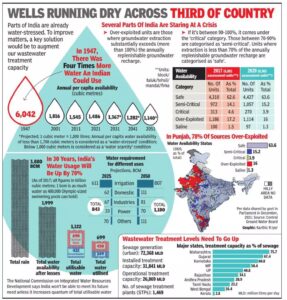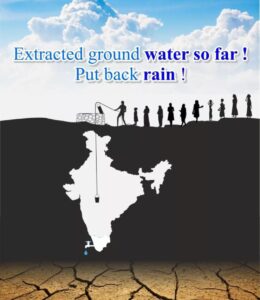
With only 2% of Earth’s landmass and 4% of freshwater resources India supports 18% of the human population and 15% of the livestock. Although not a ‘water scarce’ nation yet, it is in a ‘water-stressed’ situation with annual per capita water availability below 1,700 cubic metres. Melting of Himalayan glaciers and erratic monsoon rainfall due to climate change could further increase this stress.
To compound the crisis, indiscriminate use of groundwater, pollution of surface water and mismanagement of wastewater are common problems in India. The gap between wastewater generation and treatment capacity is also worrisome.
India treats just a third of the 72,368 million litres of sewage generated in its urban areas every day. Untreated water not only goes waste but also pollutes groundwater, rivers and other water bodies. Therefore, judicious use of water in agriculture – which consumes nearly 89% of freshwater – and efforts to reuse wastewater are key to improving the situation.
In a business-as-usual scenario, the country won’t be able to meet its future requirement without increasing water availability. While groundwater availability improved between 2017 and 2020, nearly a fifth of the assessed blocks in the country were still in a precarious condition due to over-exploitation. These blocks are concentrated in Punjab, Haryana, Delhi, west UP, Rajasthan, Gujarat, and parts of Karnataka, Andhra Pradesh, Telangana and Tamil Nadu.

The Central Ground Water Board (CGWB) says while over-exploitation of groundwater is the main problem in the northwestern region, the arid climate is to blame in Rajasthan and Gujarat. In the south, crystalline aquifers reduce the availability of groundwater.
As rainfall varies across regions, different conservation and groundwater recharge approaches may be needed across the country. But as water is a state subject, water management strategies are confi ned to the administrative boundaries of states. The absence of a unifi ed approach that regards an entire river basin as a hydrological unit makes the problem tricky. And there is a multiplicity of authorities managing the country’s water resources.
To address the challenges in the water sector, the ministry of ‘Jal Shakti’ (water resources) has started the process to make a new National Water Policy aimed at addressing the existing situation and suggesting a framework for creating a system or institution that may coordinate planning, management and use of water resources with a unifi ed national perspective. A drafting committee has already submitted its report on this to the ministry.
The government has also proposed to set up a National Bureau of Water Use Effi -ciency (NBWUE) – like the Bureau of Energy Effi ciency (BEE) in the energy sector – to improve effi cient use of water across irrigation, domestic water supply and other sectors. It will also promote water-effi cient equipment and appliances nationwide.
To bridge the gap between wastewater generation and treatment capacity, the Centre plans to create a treatment capacity of 36,668 MLD (million litres per day), which would hopefully lead to circularity in the water sector in the next few years. The National Mission for Clean Ganga (NMCG) alone has sanctioned 159 projects to create a treatment capacity of 4,929 MLD.
On the conservation front, the ministry has taken up the “Jal Shakti Abhiyan: Catch the Rain” campaign with the theme “Catch the Rain – Where it Falls, When it Falls” to cover all the blocks of all districts (rural as well as urban areas) across the country during the pre-monsoon and monsoon months (till November 30).
“The idea is to encourage states and stakeholders to create rainwater harvesting structures with people’s participation,” said G Asok Kumar, director general, NMCG. Activities under the campaign include establishment of rooftop rainwater harvesting structures, water harvesting pits, check dams, enumeration and geotagging of all water bodies in the districts, removal of encroachments, desilting of tanks and construction of new storage tanks.
The ministry is also implementing ‘Atal Bhujal Yojana’ (Atal Jal), a Rs 6,000-crore central scheme for sustainable management of groundwater resources with community participation. Atal Jal is being implemented in 81 water stressed districts and 8,774 gram panchayats of seven states – Gujarat, Haryana, Karnataka, Madhya Pradesh, Maharashtra, Rajasthan and Uttar Pradesh.
The CGWB, on the other hand, has prepared ‘Master Plan for Artifi cial Recharge to Groundwater – 2020’. It envisages construction of about 1.4 crore rainwater harvesting and artifi cial recharge structures in the country to harness 185 billion cubic metres (BCM) of water. Besides, the National Aquifer Mapping and Management programme is being implemented by the Board for mapping aquifers (water bearing formations), their characterisation and development. It will facilitate sustainable management of groundwater resources in the country.

This article is written by, Vishwa Mohan we admire this article and publish the same for the benefit of our stakeholders! Credit to him!
As published on https://timesofindia.indiatimes.com/india/how-india-aims-to-use-every-drop-of-water/articleshow/91553904.cms
India’s Passionate Rain Water Harvesting Company
